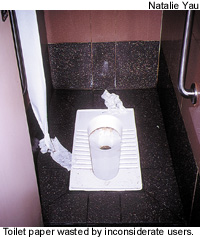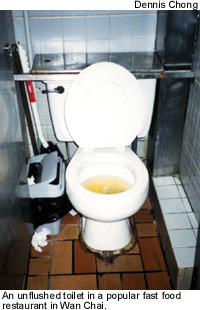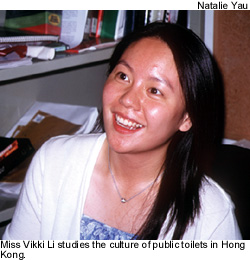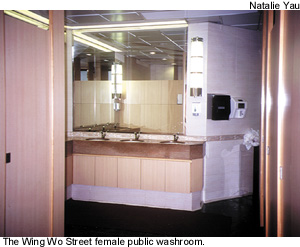
| Also featuring: | Urban Agriculture |
 Stench,
wet, dirty floors and un-flushed toilet bowls make up the general picture
of Hong Kong’s public washrooms.
Stench,
wet, dirty floors and un-flushed toilet bowls make up the general picture
of Hong Kong’s public washrooms.
Miss Vikki Li is a master of philosophy student in the Department of Anthropology at The Chinese University of Hong Kong.
In an article “Toilets and Cleanliness as a Window on Hong Kong Culture” published in the Hong Kong Anthropologist, Miss Li points out that inconsiderate users are primarily responsible for the dirtiness of local public washrooms.
“Some people are not willing to flush after using public toilets.
“They regard touching the flushing handles as touching someone else’s body waste indirectly.
“Many people squat on toilet seats to avoid dirt as much as possible, leading to even dirtier toilet seats,” said Miss Li.
Ineffective facilities also contribute to dirty washrooms.
The lack of flushing water is not a rare problem in local public toilets. Sometimes, the flushing systems are too weak to remove all the waste.
Poor ventilation systems allow odours to build up.
“Toilets here are frequently visited but not often cleaned,” said a Belgian tourist.
“Whenever I want to go to washrooms, I can go nowhere except to those in McDonald’s,” said he.
The government has not turned a blind eye to these problems.
In 1995, the Urban Council and the Regional Council co-launched a campaign called the “Public Toilet Improvement Scheme”.
 The
scheme costs $500 million and will last until 2002.
The
scheme costs $500 million and will last until 2002.
Thanks to the scheme, powerful ventilation systems have been introduced to eliminate bad smells and to maintain dry, clean floors.
Foot-operated flushing devices, water taps with infrared sensors and electronic hand dryers have been installed in many public toilets.
Alarm systems have been especially designed for disabled in case of emergency.
Toilet stalls have been equipped with grab bars for the elderly.
As of 1999, 29 public toilets in urban areas had been refurbished under this scheme.
To improve cost-effectiveness, cleansing services for all public toilets under the department have been contracted out.
Contractors have to take care of cleanliness of public toilets. They are also responsible for checking of water pipes to ensure regular functioning of flushing systems.
Moreover, the Public Toilet Improvement Scheme has employed toilet attendants in public toilets.
A spokesman for the cleaning contractors of public toilets said, “We have full-time toilet attendants on duty from 7 a.m. to 9 p.m. every day in toilets with high usage rates.”
They also replenish toilet paper and liquid soap, as well as report damaged facilities to speed up repairs.
“We have an inspection form for the toilet attendants to complete.
“If we find the conditions unsatisfactory, the attendant may subject to certain kind of penalties, say, a deduction from their salary or receiving a warning letter,” said the spokesman.
Nevertheless, public toilets are not as good as one might expect.
In a public washroom on the first floor of Lockhart Road Market in Wan Chai, a poster produced by The Food and Environmental Hygiene Department states:
“Toilet bowls, seats and flushing cisterns clean and free of dirt.
“Toilet walls and floor dry and free of dirt.
“Hand wash basins and mirrors free of dirt.”
However, there was a piece of stinking stool stuck in a squat toilet.
An attempt to flush it away failed due to the weak flushing system.
The toilet facilities were old and the floor was wet.
Brown paint was found on the mirrors.
The department denied that the poster should reflect the reality, though.
Mrs. Joyce Ma is the spokesperson for the department.
“The posters were to arouse the public’s awareness about toilet cleanliness. We put them in old washrooms which have not yet been refurbished,” she said.
Although the washrooms have not been refurbished, the department does carry out regular checks and makes minor renovations from time to time.
“Every day, we send inspectors to public toilets to monitor our contractors’ work.
“If the conditions are not satisfactory, we give a verbal warning, followed by warning letters and payment reductions,” said Mrs. Ma.
A toilet attendant working for Johnson Cleaning Services Company, one of the five contractors, complained about users’ practices.
“Even if there is a water supply, people do not flush after use. They dump waste paper everywhere,” said he.
He said that the situation was worse at night when no toilet attendants are on duty.
“They urinate everywhere,” he complained.
A supervisor for Baguio Cleaning Services Company, another of the five contractors, also blamed the users.
“Toilets become dirty just 15 minutes after they are cleaned.
“If there is a paper supply, the paper rolls will be gone within an hour,” said he.
Mrs. Ma attributed the situation not only to the users, but also to the climate in Hong Kong.
“High humidity is one of the reasons why toilet floors are often wet.”
She claimed the department had done its best with available resources.
“It doesn’t help if people do not flush after use or put litter into litter bins,” said she.
“We sweep the streets every day. But we still see litter everywhere. Litter does not move by itself. It comes from people,” said she.
Support and cooperation from the members of the public are crucial elements in maintaining hygienic public toilets.
 “Most
people here lack a sense of citizenship. Public toilets are not places
of their own. They care more about resolving their biological needs
than keeping public toilets clean,” said Miss Li.
“Most
people here lack a sense of citizenship. Public toilets are not places
of their own. They care more about resolving their biological needs
than keeping public toilets clean,” said Miss Li.
“It is very important for users to behave themselves and keep the toilets clean.
“Yet, this greatly depends on parental education,” said she.
The hygiene standard of public toilets can also be upgraded by improving facilities.
“There should be sufficient supply of toilet paper.
“With the provision of toilet paper, it was found that toilets in New Asia College at the Chinese University became significantly cleaner.
“When its provision is exhausted in the University Library toilets, they become dirtier,” Miss. Li said.
Modern technology can help solve the problem as well.
“Using automatic flush sensors – like those in Korea and Japan – is
the best way to ensure a 100 percent flushing rate. But there is a high
cost involved,” said Miss Li. ![]()
|
By Natalie Yau
|
|
In fact, not all public washrooms are in terrible
condition.
The Wing Wo Street Public Toilet in Central and the Smithfield Market Public Toilet in Western District are two good examples of clean loos. In the Provisional Urban Council Clean Public Toilets Casting Award Contest held in 1999, these two public toilets were voted the cleanest toilets in the urban area by the public. “They are very clean for public toilets. The floors are dry and the toilet compartments are clean and dry,” said a local resident who had just emerged from a toilet. There is full-time toilet attendant stationed in
the Wing Wo Street Public Toilet, while the Smithfield Market
Public Toilet is cleaned six times a day. |
 Disinfectant
is added to the flushing water. Internal ventilators have been
installed and aromatic chemicals eliminate odours.
Disinfectant
is added to the flushing water. Internal ventilators have been
installed and aromatic chemicals eliminate odours.